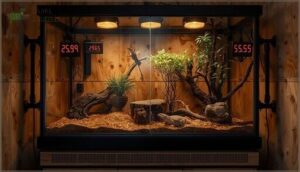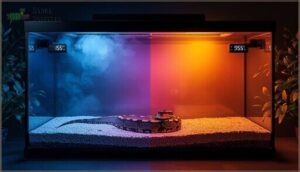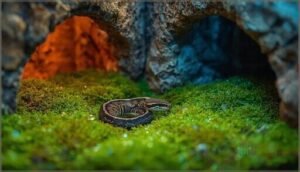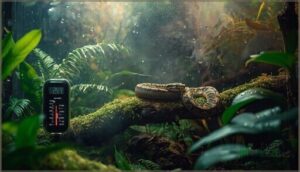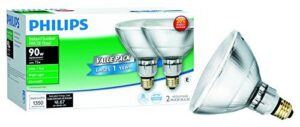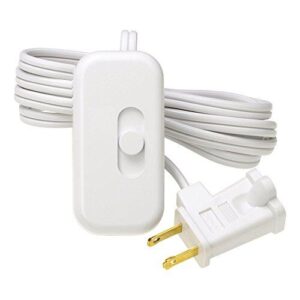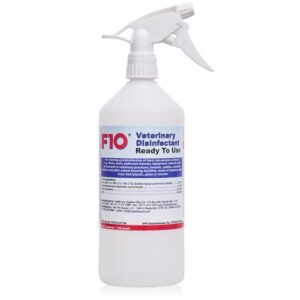This site is supported by our readers. We may earn a commission, at no cost to you, if you purchase through links.

You’ll find that maintaining precise snake breeding temperature and humidity isn’t just about turning on a heat lamp and adding a water bowl—it’s about orchestrating a microclimate that mimics the exact conditions triggering reproductive behaviors in the wild. A single-degree miscalculation during cooling cycles can prevent ovulation entirely, while humidity errors of just 10% can transform viable eggs into desiccated failures within 48 hours.
The difference between a successful breeding season and months of wasted effort often comes down to understanding how thermal gradients, vapor pressure deficit, and photoperiod work together to signal reproductive readiness. Getting these parameters right requires more than basic equipment—it demands species-specific knowledge, reliable monitoring systems, and the ability to troubleshoot environmental fluctuations before they compromise your breeding outcomes.
Table Of Contents
Key Takeaways
- Snake breeding success depends on maintaining species-specific temperature gradients (typically 75-90°F with 10°F differentials) and humidity levels (50-90% depending on species and life stage), where even single-degree errors during cooling cycles can prevent ovulation and 10% humidity miscalculations can destroy viable eggs within 48 hours.
- Effective breeding environments require creating controlled microclimates through proper enclosure setup, strategic heat source placement, adequate ventilation, and species-appropriate hiding spots—combined with reliable digital monitoring systems that track multiple zones simultaneously to catch equipment failures before they compromise reproductive outcomes.
- Seasonal brumation (cooling cycles to 50-65°F over three months) triggers the hormonal resets essential for fertility, followed by gradual warm-up periods that restore breeding readiness—with precision timing and temperature control separating successful programs from reproductive failures.
- Professional-grade equipment including digital thermostats with ±0.9°F accuracy, calibrated hygrometers, backup heat sources, and biosecurity protocols (like F10 disinfectant) form the non-negotiable foundation for maintaining stable conditions throughout critical incubation periods when embryo development demands unwavering environmental consistency.
Preparing The Ideal Breeding Environment
Your breeding program’s success starts with the physical space where your snakes will mate and thrive. The right environment isn’t just about buying an enclosure—it’s about creating a controlled microhabitat that mimics natural conditions while giving you precise control over every variable.
Let’s walk through the essential components you’ll need to set up before introducing your breeding pairs.
Choosing and Setting Up Enclosures
Your enclosure setup forms the foundation of successful reptile husbandry. Adult females need at least 3 feet long by 2 feet wide by 18 inches high to allow full body stretching, while corn snakes thrive in 48″ x 24″ x 24″ vivariums supporting climbing behavior.
When selecting enclosure materials and breeding racks, prioritize:
- Plywood or melamine construction for excellent insulation and humidity control
- Small side vents positioned near the bottom to minimize heat loss
- Adequate floor space calculated using snake length × 0.7 for length
- Rack systems for efficient temperature and humidity management
- Non-toxic substrates avoiding pine or cedar shavings
Proper vivarium setup is vital for maintaining ideal temperature control systems to verify the health and well-being of the snakes.
Creating Effective Temperature Gradients
Position your heat source on one end to establish a thermal gradient from 75°F on the cool side to 85-90°F at the warm end—this 10°F difference facilitates proper thermoregulation. You’ll need digital thermometers at both zones for continuous temperature monitoring.
Avoid heat rocks; under-tank heaters or radiant panels deliver safer, more stable incubation temperature ranges while minimizing thermal fluctuation that disrupts breeding readiness.
To create an ideal environment, understanding temperature gradients is vital for reptile health.
Ensuring Proper Ventilation and Airflow
Once you’ve set your thermal gradient, don’t overlook airflow management. Effective ventilation systems protect breathing spaces, stabilize temperature and humidity control, and support healthy Air Exchange Rates. For reliable enclosure environments:
- Use mesh tops for passive airflow.
- Place vents low and high to promote convection.
- Avoid wind tunnels.
- Adjust for species-specific humidity control—especially during breeding.
Adding Hiding Spots and Nesting Materials
Solid ventilation sets the stage—now give your snakes the refuge they need. Position at least two hiding spots per enclosure: one in the warm zone, one cool.
For gravid females, add a dedicated egg chamber filled with damp sphagnum moss to maintain 75–85% humidity.
This environmental enrichment reduces stress, stabilizes temperature control, and triggers natural nesting behavior essential for successful reptile care.
Temperature Requirements for Snake Breeding
Temperature control isn’t just important for snake breeding—it’s the foundation that determines whether your breeding program succeeds or fails. You’ll need to understand both the general ranges that work for most species and the precise requirements that make each one unique.
Temperature control is the foundation that determines whether your snake breeding program succeeds or fails
Let’s break down the specific temperature parameters you need to maintain throughout every stage of the breeding cycle.
Daytime and Nighttime Temperature Ranges
Your snakes’ thermal cycles need to mirror nature’s rhythm—temperature gradients shift constantly between day and night. Most breeding setups demand daytime ranges of 75°F to 85°F with basking temperatures reaching 88°F, then dropping to nighttime lows around 70°F to 75°F. This diurnal pattern drives thermoregulation and reproductive readiness.
- Maintain a 4°F to 9°F drop at night for physiological balance
- Position multiple heat sources to create thermal gradients across enclosures
- Monitor basking spots with digital probes for ±1°F accuracy
Species-Specific Temperature Guidelines
Each species demands precision—Ball Pythons thrive at 79–81°F ambient with 88–90°F basking spots, while Corn Snakes favor 75–85°F daytime ranges and 85–88°F basking zones. King Snakes need 75–82°F during breeding, Boa Constrictors perform best at 82–85°F, and Milk Snakes require temperature gradients from 70–75°F cool ends to 85°F warm zones.
Maintaining corn snake enclosure temperature consistency with best heat sources for corn snakes ensures reproductive success across all species.
Seasonal Cooling and Warm-Up Cycles
Generally, brumation techniques drive fertility through thermal cycles that mimic nature’s seasonal transitions. These cooling phases trigger hormonal resets essential for viable gametes.
You’ll cool your snakes gradually to 50-65°F over three months—California Kingsnakes need low 60s°F, while Bamboo Ratsnakes require low 40s°F. After brumation, warm them slowly to 75-85°F, restoring feeding and breeding readiness while adjusting humidity levels from 40-50% to 60%.
Safe Use of Heating Devices
Heat source safety starts with strategic placement—position heat mats under no more than one-fourth of your enclosure’s length to establish proper temperature gradient control.
You’ll need digital thermostats set between 40-108°F with probes placed directly on surfaces, not air.
Smart controller benefits include real-time alerts preventing thermal burns, while regular heating device maintenance through thermostat calibration ensures your infrared heat lamps and heat mats won’t malfunction.
Managing Humidity for Successful Breeding
Getting temperature right is only half the battle—humidity control separates successful breeding programs from frustrating failures.
You’ll need to maintain different moisture levels throughout the breeding cycle, from adult conditioning through incubation and hatchling care.
Let’s break down the precise humidity parameters and practical techniques that’ll keep your breeding snakes healthy and productive.
Optimal Humidity Levels for Adults and Eggs
Understanding humidity demands across different life stages separates successful breeders from those who struggle with poor hatch rates and health complications. Your adult snakes need drastically different humidity levels than their developing eggs—getting this wrong compromises everything from shedding cycles to embryonic viability.
Adult Snake Humidity Requirements by Species Type:
- Tropical species (Green Tree Pythons): Maintain 70-90% humidity for proper skin hydration and respiratory function.
- Ball pythons: Keep 50-60% baseline humidity, increasing to 60-70% during shedding phases to prevent dysecdysis.
- Temperate species (Corn snakes): Maintain 40-50% humidity for ideal health without scale rot risk.
- Desert-adapted species (Rosy Boas, Indian Sand Boas): Require 20-40% humidity, with slight increases to 30-50% during shedding.
- Breeding females: Monitor closely as low humidity can trigger egg binding and reproductive complications.
Successful egg incubation demands approximately 90% humidity regardless of species—noticeably higher than adult requirements. This elevated moisture prevents desiccation during the 50-80 day development period. You’ll need vermiculite or perlite substrates that retain moisture while allowing gas exchange, combined with sealed incubation containers featuring minimal ventilation.
Temperature control during incubation works synergistically with humidity—maintaining 78-88°F (27-31°C) alongside that critical 90% humidity creates the stable environment embryos require. Digital hygrometers placed at egg level provide accurate readings, though you’ll want multiple sensors in larger breeding environments to account for microclimates.
Desert species present an interesting exception: while their eggs still need elevated humidity compared to adult environments, they tolerate slightly lower levels (75-85%) than tropical species. That’s why species-specific research matters—assuming all snake eggs need identical conditions leads to developmental failures.
Monitor your humidity sensors daily during incubation. Fluctuations stress developing embryos and correlate directly with reduced hatch rates and weaker hatchlings. Too little humidity causes eggs to collapse and desiccate; excessive moisture promotes fungal infections that can destroy entire clutches within days.
Humidity Control Techniques and Tools
You’ll achieve precise humidity control through a combination of manual techniques and automated tools that work together to maintain stable breeding conditions. Manual methods—spraying enclosures, positioning water bowls near heat sources, and using moisture-retaining substrates—provide foundational control, while automated misting systems and reptile-specific humidifiers maintain consistency without constant intervention.
Digital hygrometers placed at multiple enclosure zones deliver accurate humidity readings, though regular hygrometer calibration ensures measurement reliability within +/- 5% of target levels.
Preventing Dehydration and Respiratory Issues
Your precise humidity management directly prevents the two most devastating breeding complications: dehydration and respiratory infections.
Ball Pythons below 55% humidity face increased osmotic water loss per breath, while corn snakes show classic dehydration signs—skin tenting and dented eye caps—when humidity drops persistently. Dehydrated snakes can lose 11-13% body mass, compromising thermoregulation and immune defense.
Respiratory problems spike when humidity imbalances persist, as dry airways permit bacterial colonization.
Monitoring and Adjusting Humidity
You can’t manage what you don’t measure. Digital hygrometers placed centrally deliver averaged readings, but wall-mounted smart monitors alert you when fluctuations exceed 10% from target.
Daily misting raises humidity 10-20% for roughly eight hours, while humid hides maintain localized 80-95% microclimates.
Corn snakes thrive at 65-75%, ball pythons at 45-60%—water bowls near heat sources and automated mist systems guarantee consistency without manual guesswork.
Top 7 Products for Temperature and Humidity Control
Getting your breeding setup right means investing in reliable equipment that won’t fail when your snakes need it most. You’ll need precise temperature controllers, accurate monitoring tools, and quality heating elements that maintain stable conditions around the clock.
Here are seven proven products that serious breeders rely on to keep their environmental parameters exactly where they need to be.
1. Reptile Uvb Lighting Solution Lamp
When you’re breeding corn snakes, UVB lighting shifts from optional to essential. Corn snake lighting requirements aren’t as demanding as diurnal species, but UVB output facilitates vitamin D3 synthesis that directly impacts egg calcium content and hatchling viability.
You’ll want ReptiSun 5.0 fluorescent tubes positioned 12 inches above basking zones—this lamp placement delivers appropriate UVI for crepuscular species. Match your reptile lighting to Ferguson Zones: corn snakes thrive in Zone 2 conditions.
Replace UVB lamp types every 6–12 months, even when they’re still glowing, since output degrades long before burnout.
2. Reptile Uv Light Meter Tool
Guessing UVB output won’t cut it when your corn snake breeding depends on precise exposure. The Solarmeter 6.5 reads UV Index from 0 to 199.9 across the 280–400 nm spectrum, letting you map UV gradients inside each enclosure with NIST-traceable accuracy.
You’ll verify lamp placement delivers Ferguson Zone 2 levels—usually 1.0 to 3.0 UVI at basking sites—and catch output decay before your bulbs fail.
Annual UV meter calibration keeps readings within ±3.5%, so you’re measuring real photon flux, not hope.
3. Dimmable Halogen Flood Light Bulbs
Heat lamps alone create hotspots that stress gravid females and crash overnight. A 72-watt Philips PAR38 halogen bulb paired with dimming controls solves both problems—you dial basking temperature from 88°F down to ambient 74°F without swapping fixtures.
The 2880 K spectrum penetrates scales for deep-tissue warming ball pythons need during follicle development, while instant-on eliminates the cold-start lag that disrupts lighting cycles.
Expect 2,000–4,000 operational hours before filament decay forces replacement, so stock spares and budget $8.67 annual energy cost per socket.
4. Lutron Plug In Lamp Dimmer
You can’t afford trial-and-error on heat source intensity when gravid females shut down from overnight temperature swings. This dimmer integrates with your halogen or incandescent fixtures through wireless control via Clear Connect RF, operating at 868 MHz across 9 meters through walls.
The 300-watt load capacity manages multiple lamps simultaneously, tuning your temperature gradient from basking to ambient without rewiring circuits.
With 10-year design life and $9.24 annual energy savings per unit, the system pays for itself while maintaining stable thermostat-verified conditions your breeding pairs demand.
5. Herpstat Digital Temperature Controller Plus
Proportional dimming beats on-off thermostats when incubating clutches worth thousands. The Herpstat Digital Temperature Controller Plus delivers precision control within ±0.9°F through continuous monitoring, while its built-in safety relay cuts power if sensor readings drift beyond your programmed parameters.
You’ll configure four daily temperature ramping cycles to simulate natural photoperiods, and the optional humidity management probe tracks moisture levels alongside thermal gradients.
Remote monitoring via Wi-Fi lets you verify conditions from anywhere, protecting your investment during critical egg development phases without midnight enclosure checks.
6. Smart Temperature Control Thermostat
IoT-connected smart sensors transform breeding operations when you’re managing multiple projects simultaneously. The Inkbird ITC-306T thermostat delivers dual-display monitoring with automated alerts that text you before heat mats malfunction, while its day/night cycle programming creates temperature gradients without manual adjustments.
You’ll calibrate digital probe thermometers once and trust the 10A relay to maintain your 80-84°F incubation sweet spot. Energy efficiency improves 17% compared to mechanical units, and thermostat settings survive power outages through memory retention—critical during storm season when clutches can’t wait.
7. Pet Friendly Disinfectant Cleaner Spray
Biosecurity failures between breeding cycles introduce pathogens that compromise clutch viability faster than any temperature gradient miscalculation. F10 Ready-to-Use Disinfectant Spray eliminates viruses, bacteria, and fungi without phenols that damage respiratory systems—EPA registration 79755-5 confirms broad-spectrum cleaner efficacy while remaining biodegradable.
You’ll spray enclosures, heat source surfaces, and humidity monitoring equipment, then wait until completely dry before reintroducing animals. This pet health protocol maintains disinfectant safety standards that protect both adults and hatchlings, though concentrate formulations offer better value for large-scale operations requiring eco-friendly options.
Monitoring and Troubleshooting Breeding Conditions
You can’t manage what you don’t measure, and breeding success hinges on accurate monitoring of your environmental parameters. Even with premium equipment, conditions can drift or fail without consistent oversight.
This section covers the essential monitoring tools you’ll need, the warning signs that indicate trouble, practical solutions to common problems, and strategies for maintaining rock-solid stability throughout the critical incubation period.
Using Thermostats and Hygrometers
Your breeding program lives or dies by your instruments. Install thermostats with probes positioned at both heat source and cool end to verify accurate temperature gradients—calibrate them against secondary measurement tools quarterly.
Digital hygrometers with dual sensors deliver reliable humidity monitoring when placed strategically across enclosure zones. Don’t trust a single device; cross-reference readings to catch calibration drift before it compromises your breeding outcomes.
Recognizing Signs of Improper Conditions
Your snakes telegraph environmental problems long before instruments fail. Watch for behavioral changes like constant heat-seeking or prolonged soaking—these signal temperature stress or humidity imbalance disrupting thermoregulation.
Respiratory issues manifest as wheezing or mucus discharge when temperature control falters below species thresholds. Retained sheds indicate dehydration from inadequate humidity levels, while regurgitation follows exposure to improper temperature gradients.
Health monitoring catches these warning signs early, preserving your breeding investment.
Addressing Common Environmental Issues
When problems arise, your response determines breeding success. Environmental monitoring reveals issues, but corrective action separates amateur efforts from professional outcomes. Here’s how you’ll tackle common challenges:
- Temperature fluctuations: Install backup heat sources with independent thermostats to prevent dangerous drops
- Ventilation issues: Add adjustable vents or screen modifications for controlled airflow management
- Humidity control failures: Layer moisture-retentive substrates with deep water bowls for stable levels
- Temperature gradient collapse: Reposition your heat source away from cool zones, verifying with multiple probes
- Airflow-related mold: Increase ventilation while maintaining target humidity through substrate adjustments
Maintaining Consistency During Incubation
Once you’ve addressed immediate problems, your focus shifts to maintaining stable conditions throughout the entire incubation period. Temperature precision within 80-88°F and humidity control at 85-95% directly determine hatch success—fluctuations beyond 1°C compromise embryo development.
Daily egg monitoring with calibrated equipment catches deviations early, while breeding optimization requires minimizing incubator openings that disrupt your carefully established temperature gradient and incubation stability.
Frequently Asked Questions (FAQs)
How does altitude affect snake breeding humidity needs?
At 2,800 meters, lower atmospheric humidity threatens egg viability through accelerated desiccation.
You’ll need moisture-retentive substrates like vermiculite and active humidity control—maintaining 60-75% relative humidity counteracts altitude’s dehydrating effects on developing embryos.
What humidity levels prevent scale rot during breeding?
You’ll want to maintain humidity between 50-60% for most breeding snakes to prevent scale rot. Combined with proper ventilation and clean substrates, these humidity levels minimize bacterial growth while supporting healthy sheds and overall snake health.
Do different morphs require unique temperature parameters?
Most morphs within the same species don’t demand wildly different breeding temperatures—they thrive in identical thermal ranges. However, you’ll adjust humidity levels based on morph origins: desert types need 40-50%, while tropical morphs require 70-75% for ideal reproductive success.
How often should breeding room conditions be calibrated?
You should calibrate temperature control and thermostat sensors every three to six months.
During critical incubation periods, weekly sensor accuracy checks guarantee environmental consistency and breeding cycle optimization, preventing equipment maintenance issues that compromise humidity levels.
Conclusion
Think of your breeding operation as conducting an orchestra—every instrument must stay precisely in tune, or the entire performance falls apart. Snake breeding temperature and humidity represent your two lead violinists, and even slight dissonance creates cascading failures.
Master the monitoring systems, respect species-specific thresholds, and intervene before subtle shifts become reproductive disasters. Your reward isn’t just viable clutches—it’s the confidence that comes from controlling variables most breeders leave to chance.
- https://www.semanticscholar.org/paper/Does-exposure-to-UVB-light-influence-the-growth-and-Palmer/0014580c213ab41081af864d56ed6bae3332c81d
- http://www.lightyourreptiles.com/arcadia-d3-t-5-22-inch-24-watt-6-forest-uvb/
- https://www.reptilebasics.com/t5-light-fixtures/shadedweller-max/
- https://vetronic.co.uk/2018/wp-content/uploads/2020/05/Suggested-values-for-ventilation-of-some-exotic-species.pdf
- https://exoticreptilesforsale.com/ensuring-proper-ventilation-air-flow-and-circulation-in-reptile-living-spaces/

